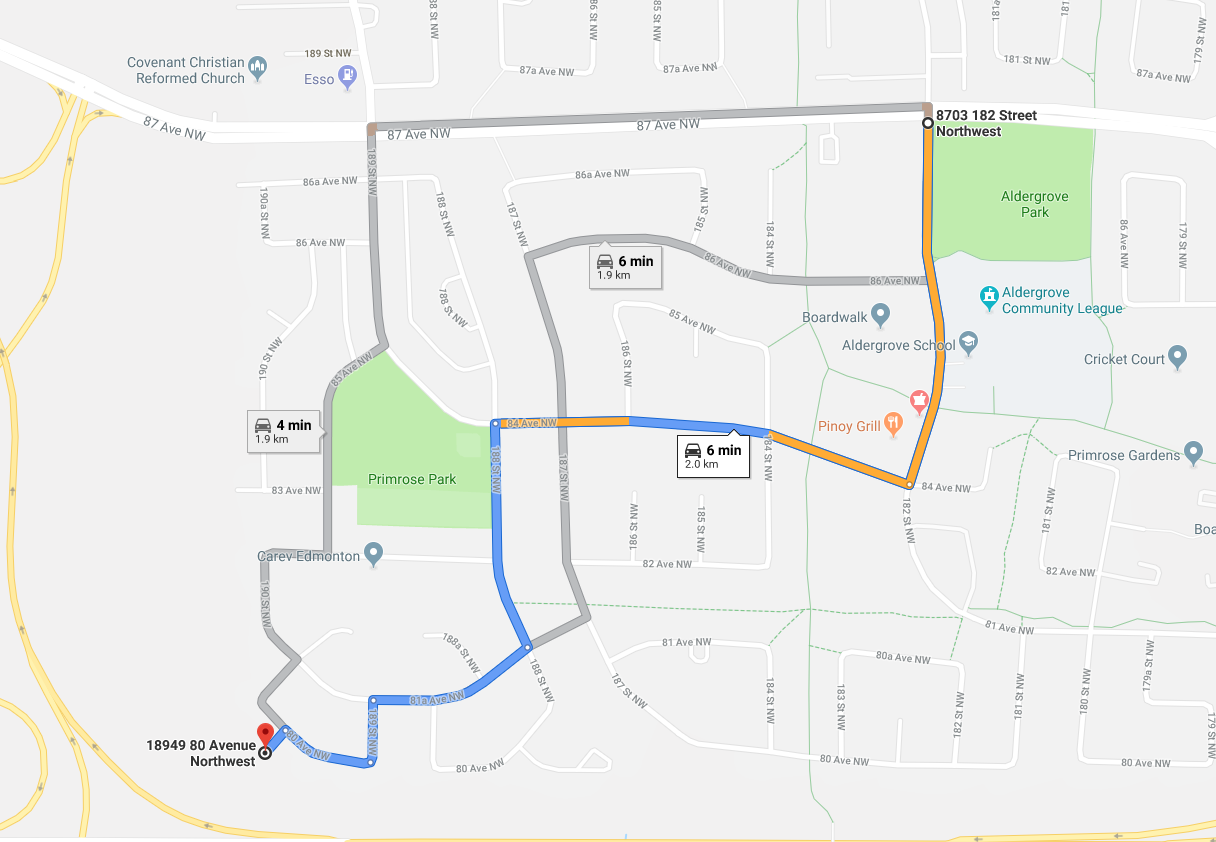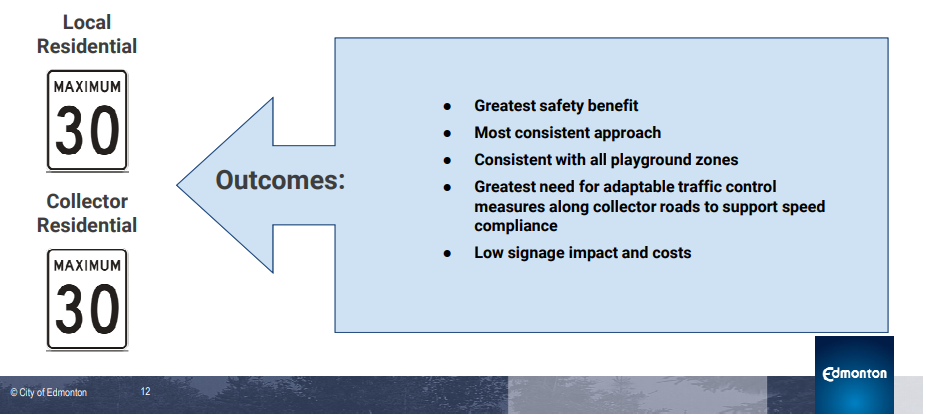Safer Speeds in Edmonton
The decision Edmonton City Council made on May 15, 2019 will result in a 40km/h speed limit on residential roads within our communities across the city as well as 30km/h speed limit within the YegCoreZone.
While this work will take a few months, I want to share why I supported lowering the speed limit within our communities. If you haven’t already, I would encourage you to read through my previous blog posts (Fast Speeds, Slow Solutions, Speed Limit Outcomes: Simple and Consistent) for more background.
First of all, I want to provide some examples of roads that will NOT be impacted by a speed reduction.
In Ward 1 that would include streets like 142nd/149th/156th/163rd/170th 178th/215th (Winterburn Rd)/231st and avenues like 87th (including Webber Greens Drive)/95th (west of 149th street)/100th/Stony Plain Road/107th/111th 118th/137th.
The purpose of providing those examples is to clearly state that arterial roads and major collector roads (ex: 95th Ave west of 149th Street) will NOT see a speed reduction.
95th Avenue is currently listed as a collector road. 95th Avenue west of 149 st, while identified as a collector road, will be excluded from this process. The motion passed yesterday asks city administration to work with communities over the next few months to identify the anomalies before implementation. These are the roads we commute on and maintaining the existing speeds is critical to ensuring the efficient movement of people and goods. The roads that are being discussed in this blog post are the roads within our communities.
As shown below, the YegCoreZone currently cuts the community of Crestwood and Parkview in half, making them have different speed zones on either side of 142 St. I would like to see the map adjusted so that Crestwood and Parkview will have the same 40 km/hr speed limit as the rest of Ward 1.Map Credit: Troy Pavlek
Reducing speed limits within our communities was a part of my platform when I ran for re-election in 2017. The reason this was included in my platform is that I was regularly receiving - and continue to receive - traffic safety concerns from residents and community leagues across Ward 1. The primary challenge with addressing these concerns is we do not have the financial resources needed to address all of the traffic safety initiatives within our communities. Speed limits are one of the tools available to address traffic safety and because of the creation of our City Charter, the City of Edmonton now has the ability to change the default speed limit which significantly reduces the requirements for signage which in turn reduces the costs to implement new speed limits in neighbourhoods.
I have a number of reasons that I supported the reduction of speeds within our communities and want to cover each of them below.
Community DemandIn March of 2018, the city put out a public survey which asked Edmontonians what they thought about speed limits. The results were 72% of the nearly 700 asked wanted residential speed limits to be slower. The reason this survey went out at that time is that there was a change in provincial legislation which would allow Edmonton to change its default speed limits in neighbourhoods, which are set to 50 km/h. It should be noted that this hasn’t just been discussed by a small group. It started over 10 years ago when the Edmonton Federation of Community Leagues raised this with the Council of the day because many of the communities across the city were experiencing (and continue to experience) traffic safety issues. Upon completion of the 40km/h pilot, 5 of the 6 communities had a majority of residents support retaining the slower speed. The one community that didn’t support retaining the lower speed was due in part to a main collector road being included in the reduction. This is an important point and I believe the inclusion of the requirement to deal with the anomalies will ensure we can catch issues like this one prior to implementing speed limit changes.
In every city-wide statistically significant survey since then, the majority of Edmontonians have supported a slower speed on the local roads within communities but there has not been clear support on whether that speed should be 40km/h or 30km/h.Traffic safety concerns have continued to rise across most of the communities in Ward 1. The feedback has been provided at community events, when I knock on doors, and through the emails/calls that I receive. Back in 2016, the Parkview Community League worked towards solutions to eliminate traffic shortcutting and speeding through local school zones as a result of the effective traffic controls that have been implemented in Crestwood. As a result, the Community League struck a Parkview Traffic Safety Committee (PTSC) which created a Draft Discussion Guide. This guide included background information on traffic issues, systemic causes and local impacts of speeding and neighbourhood short-cutting, and other analysis on road safety. But due to a lack of funding, only a few measures were implemented and there are still concerns that exist today.
Almost every community in the Ward has a few roads where that need attention. Addressing these concerns through road design is ideal but since we don’t have much funding for adaptable measures, we are primarily going to address the design concerns through our Neighbourhood Renewal Program.
Impact on Travel Time
A concern I have heard is around how much time this could add to our commute. For reference, I tried to find the furthest distance someone in Ward 1 might have to travel on local roads to reach an arterial road. The longest distance I could find using Google Maps is approximately 2km. That would be someone living in the southwest corner of Aldergrove taking a fairly odd route to the 87th Avenue/182nd Street intersection.
This example also unfairly assumes that this person would be able to maintain a 50km/h speed for the entire 2km and that they wouldn't be stopping at stop signs, yielding at yield signs, or slowing down to take a turn. In this extreme example, the difference in travel time between 50km/h and 40km/h would be 36 seconds. This goes to show that lowering speed limits has a minimal impact on travel times and is a small trade-off for increased safety and decreased traffic fatalities. It is worth noting that this example is the furthest distance possible that I could find. As you can imagine, the average person has a much shorter distance from an arterial road to their home and the average person will take a turn slowly while also obeying traffic signs. Therefore the average person will see a total impact far less than 36 seconds but I felt that by providing the most extreme example, it would help alleviate any concerns that there will be a measurable impact to our commutes.
Safety and Liveability Improvements
When speed limits are lowered to 30 km/hr, the chances of survival if there is a pedestrian/car collision is substantially higher than at 40 km/hr or 50 km/hr.
Over the past 10 years, 13 people have died in pedestrian/car collisions on residential roads and hundreds more have been seriously injured. Moving towards a lower speed limit in Edmonton is part of the Vision Zero goal to have no deaths from traffic incidents. Not only does this increase safety, but it also increased the enjoyment and liveability of our communities. A neighbourhood where people are more comfortable letting their kids walk to the playground, going across the street to say hi to a neighbour, and have families out walking their dogs with less fear about road safety, will make our communities more vibrant.
Driving is a very habitual practice for most people. They take the same road to work every day, go the same speed, and have a routine time they travel. Although there might be a transition period while some get used to driving a little slower in residential areas, I believe this will be a very positive change for Edmonton. Although this transition will not happen overnight, I am proud that the City has taken a bold step to achieve Vision Zero and make Edmonton a better place to live. Before any changes are made, there will be a public hearing where any Edmontonian can come out to share any additional feedback. There will also be more engagement and research from the Administration so that in January 2020, Council can make the most informed decision possible.#yeg #yegcc #yegroads






